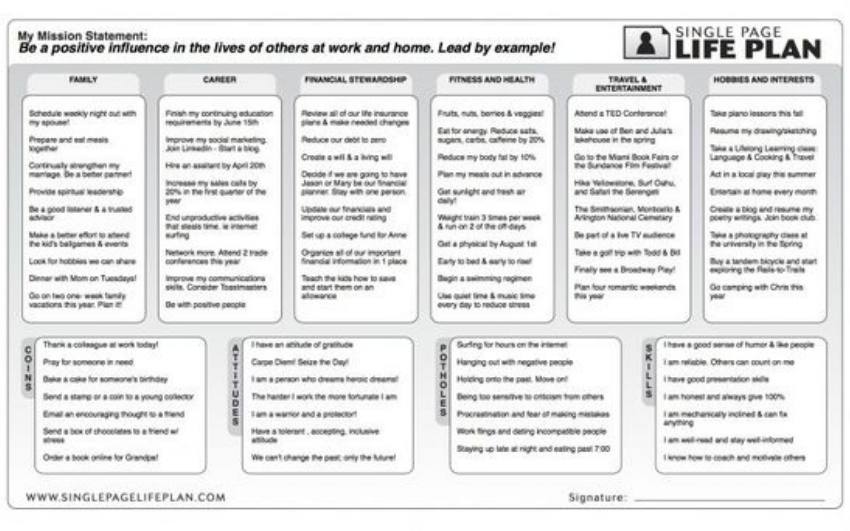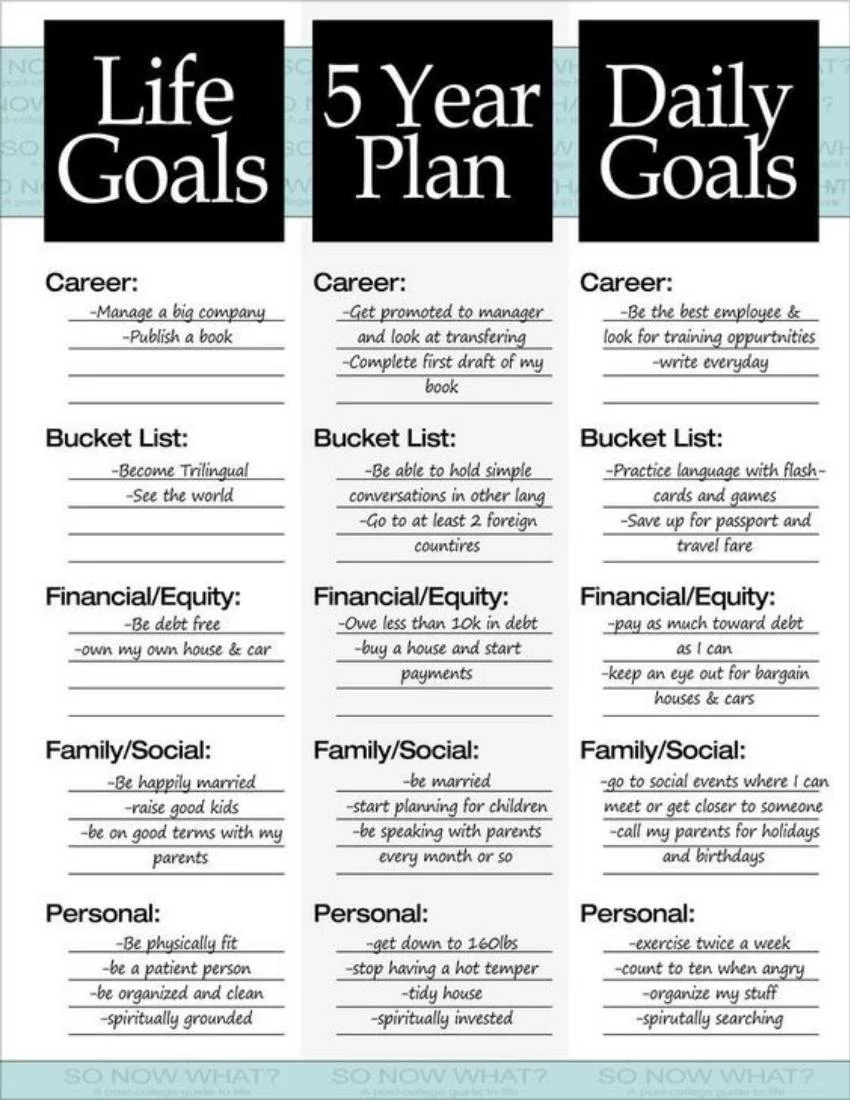On this page

How To Create An Exciting Life Plan in 30 Minutes or Less
Do you have a life plan? If not, you should probably start thinking about creating one.
Making a life plan can help you stay on track and achieve your goals. It can be exciting to think about all the possibilities that are open to you, and it’s worth taking the time to create a plan that will help you reach your dreams!
When it comes to creating exciting life planning, many people feel overwhelmed. They don’t know where to start, or they feel like they need to have everything figured out before getting started. But this isn’t the case at all!
Here are a few tips on creating an exciting and achievable life plan.
By following these simple steps, you’ll be well on your way to living the life you’ve always dreamed of. So what are you waiting for?
Get started today!
What is a Life Plan?
A life plan is a road map to help you achieve your smart goals and dreams. It’s important to have one because it can keep you motivated and on track. It is a personal guide that includes your core values, goals, and action steps. Developing a life planning can help you clarify what you want, set priorities, and make better decisions.
A life plan doesn’t need to be complicated, but it should be specific enough so that you can follow it.
Creating a life plan does not have to be complicated. You can start by brainstorming your values, goals, and action steps. Once you have these items, you can begin to put them into a format that will work. Some people prefer to write their life plans in a journal, while others prefer to create a more formal document.
The most important thing is to get started and to keep moving forward. A life plan is not something that you create and then forget about. It is a dynamic document that should be reviewed and revised regularly. As your life changes, so should your life plan.
So what are you waiting for? Get started on creating your life plan today!
Types of Life Plans To Create

There are many different types of life plans that you can create. The most important thing is to choose a plan that will work for you and your unique situation. Here are a few different types of life plans to consider:
Planning for life: This type of life plan is focused on your long-term vision and dreams life. It includes your values, mission statement, and action steps.
Self-development plan: This life plan focuses on your personal growth and development. It includes your goals, action steps, and a timeline.
Financial plan: This type of life plan is focused on your financial goals. It includes your income, expenses, debts, and savings.
Development career plan: This type of life plan is focused on your career development. It includes your goals, action steps, and a timeline.
Travel plan: This type of life plan is focused on your travel goals. It includes your dream life destinations, budget, and action steps.
Education plan: This type of life plan is focused on your educational goals. It includes your degree, school, and action steps.
Retirement plan: This life plan focuses on your retirement goals. It includes your savings, income, and expenses.
No matter what type of life plan template you choose to create, the most important thing is to get started. By taking the time to develop a life plan, you’ll be well on your way to achieving your dreams!
How To Create A Life Plan in 6 Steps

How to make a life plan can seem like a daunting task, but it doesn’t have to be! By following these simple steps, you’ll be well on your way to writing your personal life plan.
Step One: Define your values.
Defining your personal values is essential in creating a life plan. After all, how can you set goals and create a path to success if you don’t know what you value? Furthermore, your values can change over time, so it’s important to revisit them periodically to ensure they’re still aligned with your current priorities.
There are many ways to define your values, but one approach is to start by brainstorming a list of things that are important to you. Once you have a list, you can narrow it down by identifying the values that underpin those items. For example, if one of your items is “spend more time with family,” some of the underlying values might be “connection,” “love,” and “happiness.” By taking the time to define your values, you’ll be better equipped to create a life plan that meets your needs and brings you fulfillment.
Step Two: Set your goals.
Setting life plan goals is an important step in achieving success, but it’s not always easy to know where to start. One helpful way to set goals is to create a life plan. A life plan is a road map that can help you achieve your dreams and reach your full potential.
It can be as simple or as complex as you want, but the important thing is to take the time to think about what you want to achieve. Setting goals becomes much easier once you have a life plan because you have a roadmap to follow. So take the time to set your goals, and then get started on your journey to achieving them!
Step Three: Develop your action steps.
After you have identified your goals and objectives, it’s time to develop an action plan. This will involve breaking down your goals into smaller, more manageable steps. For example, suppose your goal is to get a promotion at work. In that case, your action steps might include:
- Completing additional training or certification.
- Networking with influential people in your field.
- Targeting specific opportunities that fit your skillset.
The key is to develop a roadmap that will help you achieve your desired outcome. By taking the time to develop concrete action steps, you can increase your chances of achieving success.
Step Four: Create a timeline.
Creating a timeline for your life plan is an important step in helping you to achieve your goals. By breaking down your goals into smaller, more manageable steps, you can better track your progress and ensure that you are on track to achieving your overall objectives.
Additionally, a timeline can help to keep your accountability partner to yourself and stay motivated to continue working towards your goals.
When creating a timeline, be sure to consider both short-term and long-term goals, and try to break down each goal into realistic and achievable steps. Doing so will help increase your chances of success and allow you to better track and monitor your progress.
Step Five: Make a budget.
The fifth step in creating your life plan is to make a budget. This may seem daunting, but it’s quite simple. Start by listing all of your income sources and all of your expenses. Include both fixed costs (e.g., mortgage payments) and variable costs (e.g., food and entertainment). Once you have a complete list, you can start to identify areas where you can cut back on spending.
Perhaps you can eat out less often or switch to a cheaper cell phone plan. The key is to find ways to reduce your expenses without compromising your quality of life. By creating a budget, you’ll be able to see exactly how much money you have available to save each month. And remember, even small changes can add up over time!
Step Six: Review and revise your life plan.
It’s important to review and revise your life plan periodically. After all, your goals and priorities may change over time. What’s important to you now may not be as important to you in the future. For example, if you’re currently focused on advancing in your career, you may want to set goals that will help you get promoted or land a new job.
Alternatively, if you’re thinking about starting a family, you may want to adjust your financial goals accordingly. By reviewing and revising your life plan, you can make sure that it still aligns with your current needs and aspirations.
By following these simple steps, you’ll be well on your way to writing your own personal life plan. So what are you waiting for? Get started today!
Life Plan Examples
No matter where you are in life, it’s never too late to start planning for your future. By mapping out a life plan, you can set goals and work towards a better tomorrow. Not sure where to start?
Check out this single page life plan example for inspiration.

If you’re in your 20s and just starting out, you may be wondering what the next steps are. A good place to start is by creating a 5-year plan. This can help you set both long-term and short-term goals and map out a path to achieving them.
For example, your 5-year plan may include goals such as finishing school, landing your dream job, or saving up for a down payment on a house.
Check out this five year life plan.

For those in their 30s or 40s, you may be at a point where you’ve to accomplish some of your major goals but still have more that you want to achieve. At this stage in life, it can be helpful to create a 10-year plan. This can give you a longer time frame to work towards goals such as starting with a family member, buying a vacation home, or retiring early.
No matter what your age or stage in life, remember that it’s never too late to start planning for your future.
What Are The Components of A Life Plan?

A life plan is a comprehensive document that outlines your short-term, long-term plan and unique approach to life.
It includes your:
- goals
- values
- priorities
- strategies
for achieving them.
As you begin to create your own life plan, it’s important to understand the different components that should be included.
When it comes to creating a plan for your life, there are a few key components to keep in mind.
First, it’s important to have a clear understanding of your goals and what you want to achieve.
What are your short-term and long-term goals?
What kind of lifestyle do you want to live?
Once you have a good understanding of your goals, you can begin to map out a path to achieve them.
Another important component of a life plan is setting realistic deadlines. It’s important to break down your goals into smaller, manageable steps and give yourself deadlines for each step. This will help you stay on track and motivated as you work towards your goals.
Finally, it’s also important to have a support system in place. Surround yourself with people who will encourage and support you as you work towards your goals. These people can be friends, family, or even professional coaches or mentors. Having supportive people in your life will make the journey towards your goals that much easier.
So, when it comes to creating a life plan, keep these key components in mind. With clear goals, realistic deadlines, and a supportive network, you’ll be well on your way to achieving your dreams.
By understanding these components, you’ll be well on your way to creating a life plan that works for you.
What are your life goals?
Do you want to travel the world? Do you want to start your own business? Do you want to get married and have kids? Or, do you simply want to be happy and fulfilled?
No matter what your goals are, it’s important to have a plan and work towards achieving them.
What is your 5-Year Plan?
Example:
I have many goals I would like to accomplish in the next five years. My top goal is to finish my degree and start my career in marketing. Additionally, I would like to travel more, learn a new language, and buy a house. Finally, I want to be happy and fulfilled in whatever I do.
What are your Daily Goals?
Your daily goals must be in coherence with your life goals and your 5-year plan.
For instance, if one of your life goals is to get promoted at work, then some of your daily goals might be to show up on time for work every day, dress professionally, take on extra assignments, and so on.
Conclusion
By creating a healthy life plan, you can set both long-term and short-term goals and map out a path to achieving them.
A good plan is a comprehensive document that outlines your unique approach to life. It includes your goals, values, and priorities, as well as your strategies for achieving them.
By understanding these components, you’ll be well on your way to creating a life plan that works for you.
Now that you know how to create a life plan, it’s time to start setting some goals. Check out these goal-setting tips to help you get started.
And if you’re looking for more inspiration, be sure to check out these life plan examples. No matter where you are in life, there’s a plan that can work for you!
Faqs
What is a life plan?
A life plan is a document that outlines your goals and objectives for the future. It can be as specific or as general as you want, but it should include both short-term and long-term goals, as well as steps you’ll take to achieve them.
A life plan can help you stay focused on what’s important to you, and it can also serve as a roadmap to help you stay on track. If you ever feel lost or uncertain about what to do next, refer back to your life plan, and it will help steer you back in the right direction.
How can I plan my future?
One way to plan your future is to think about what you want to achieve and then come up with a plan of action that will help you reach your goals. You can also make a list of possible obstacles that might stand in your way and come up with strategies for overcoming them.
Finally, it’s a good idea to think positive, stay optimistic and keep your eye on the prize, even when things get tough. With hard work and determination, you can achieve anything you set your mind to!
How do I make a 2-year life plan?
Start by thinking about your long-term goals and what you want to achieve in the next two years. Then, break down those goals into smaller, more manageable steps.
Give yourself deadlines for each step, and make sure you have a support system in place to help you stay on track. Finally, remember to be flexible and adjust your plan as needed. Life is always changing, so your plan should be able to change with it.
What is the best goal in life?
The best goal in life is the one that’s most important to you. Only you can decide what that is, but some examples might be becoming financially independent, manifesting your soulmate, or making a difference in the world.
Whatever it is, make sure it’s something you’re passionate about and willing to work hard for. With dedication and perseverance, you can achieve anything you set your mind to!
Related:

Petri Maatta is a mindset coach and neuroscience-focused author with 15 years of experience in personal transformation and success psychology. After seven years of business failures, he discovered the power of manifestation through a Fortune 500 mentor. Now, he shares neuroscience-backed strategies through DreamMaker membership, helping others transform their businesses and lives on their own terms.
Read My Story here.
Share This Story, Choose Your Platform!
You want to manifest a new car, but you’re wondering: Does this really work? Here’s
Many smart individuals are often linked with having a high IQ. However, according to emotional
According to online dating statistics over 90% of people believe in love at first sight,




